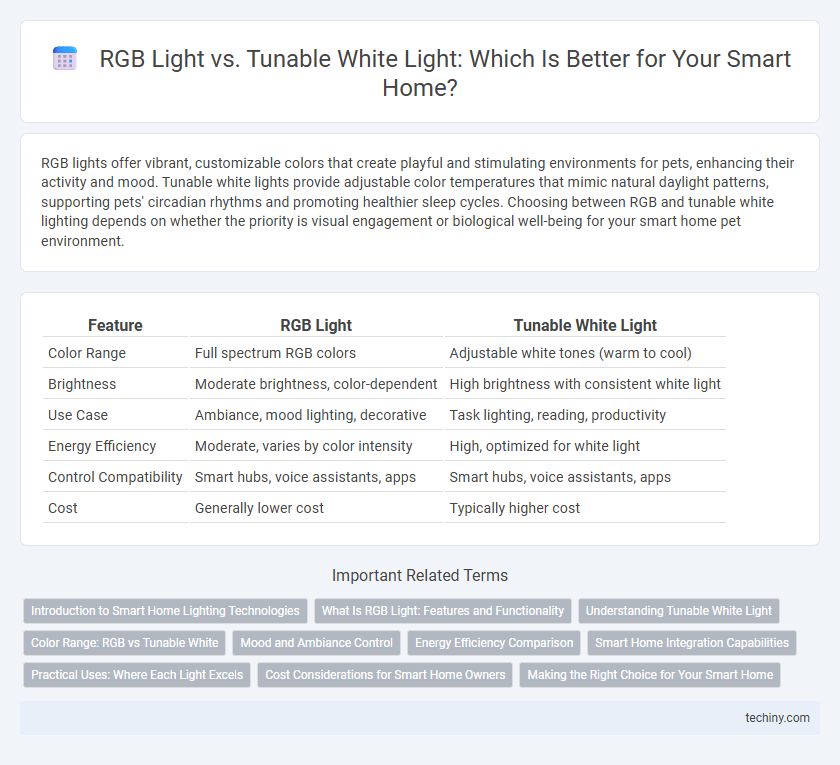RGB lights offer vibrant, customizable colors that create playful and stimulating environments for pets, enhancing their activity and mood. Tunable white lights provide adjustable color temperatures that mimic natural daylight patterns, supporting pets' circadian rhythms and promoting healthier sleep cycles. Choosing between RGB and tunable white lighting depends on whether the priority is visual engagement or biological well-being for your smart home pet environment.
Table of Comparison
| Feature | RGB Light | Tunable White Light |
|---|---|---|
| Color Range | Full spectrum RGB colors | Adjustable white tones (warm to cool) |
| Brightness | Moderate brightness, color-dependent | High brightness with consistent white light |
| Use Case | Ambiance, mood lighting, decorative | Task lighting, reading, productivity |
| Energy Efficiency | Moderate, varies by color intensity | High, optimized for white light |
| Control Compatibility | Smart hubs, voice assistants, apps | Smart hubs, voice assistants, apps |
| Cost | Generally lower cost | Typically higher cost |
Introduction to Smart Home Lighting Technologies
RGB lights provide customizable color options by mixing red, green, and blue LEDs, enhancing ambiance and mood in smart homes. Tunable white lights offer adjustable color temperatures, ranging from warm to cool white, promoting comfort and productivity. Both technologies integrate with smart home systems, enabling automation, remote control, and energy efficiency.
What Is RGB Light: Features and Functionality
RGB light in smart homes uses red, green, and blue LEDs to create a wide spectrum of colors by adjusting the intensity of each channel. It offers customizable lighting scenarios for mood enhancement, entertainment, and decorative purposes. This technology enables dynamic color changes and effects, controlled via smart devices or voice assistants.
Understanding Tunable White Light
Tunable white light in smart home systems allows users to adjust the color temperature from warm to cool white, enhancing comfort and productivity by mimicking natural daylight patterns. Unlike RGB lights that change colors across the spectrum, tunable white lights focus exclusively on varying white hues, providing better control over ambiance and circadian rhythm support. This feature is especially beneficial for tasks that require specific lighting conditions, such as reading, cooking, or relaxing.
Color Range: RGB vs Tunable White
RGB lights offer a broad spectrum of colors by combining red, green, and blue LEDs, enabling millions of hues for customizable ambiance. Tunable white lights focus on adjusting color temperature within a white light range, from warm yellowish tones to cool bluish shades, enhancing mood and functionality. RGB lights prioritize vibrant color diversity, while tunable white lights emphasize precise control over white light temperature for comfort and productivity.
Mood and Ambiance Control
RGB lights offer vibrant color options that create dynamic and personalized mood settings, ideal for parties or creative atmospheres. Tunable white lights adjust color temperature from warm to cool white, enhancing comfort and relaxation by mimicking natural daylight cycles. Both technologies enable precise ambiance control, with RGB focusing on vivid color effects and tunable white emphasizing subtle shifts in light tone for improved well-being.
Energy Efficiency Comparison
RGB lights consume more energy due to their need for multiple LEDs to create different colors, while tunable white lights use adjustable white LEDs that optimize energy use by varying color temperature and brightness. Tunable white lighting systems often feature advanced dimming capabilities that reduce power consumption, enhancing overall energy efficiency in smart home environments. Energy savings with tunable white lights can reach up to 30% compared to standard RGB setups, making them a preferred choice for sustainable smart lighting solutions.
Smart Home Integration Capabilities
RGB lights offer dynamic color-changing capabilities controlled via smart home systems, allowing users to customize ambiance through voice commands or mobile apps. Tunable white lights provide adjustable color temperatures, enabling optimization of lighting for activities or circadian rhythm support, seamlessly integrating with smart home automation platforms. Both lighting types support compatibility with major hubs like Alexa, Google Home, and Apple HomeKit, but tunable white excels in wellness-focused lighting scenarios.
Practical Uses: Where Each Light Excels
RGB lights excel in creating dynamic and customizable ambiance through a wide range of colors, ideal for mood setting, parties, and entertainment areas. Tunable white lights provide practical benefits by adjusting color temperature from warm to cool white, enhancing focus, relaxation, or sleep in workspaces, living rooms, and bedrooms. Combining both light types in a smart home setup maximizes versatility for both vibrant aesthetics and functional lighting needs.
Cost Considerations for Smart Home Owners
RGB lights typically cost more upfront due to their ability to display millions of colors, but they offer versatile ambiance for smart homes. Tunable white lights are generally more affordable and provide adjustable warmth and brightness, ideal for enhancing comfort and productivity. Smart home owners should weigh initial expenses against long-term energy savings and desired lighting effects when choosing between RGB and tunable white lighting solutions.
Making the Right Choice for Your Smart Home
Choosing between RGB lights and tunable white lights depends on your smart home's primary needs; RGB lights offer vibrant color customization for ambiance and mood, while tunable white lights provide adjustable color temperature to enhance comfort and productivity. RGB lighting excels in entertainment and aesthetic appeal, perfect for dynamic environments, whereas tunable white is ideal for task-oriented spaces requiring natural daylight simulation. Assessing your lifestyle and space function helps determine whether dynamic color versatility or precise white light tuning best suits your smart home lighting strategy.
RGB Light vs Tunable White Light Infographic

 techiny.com
techiny.com